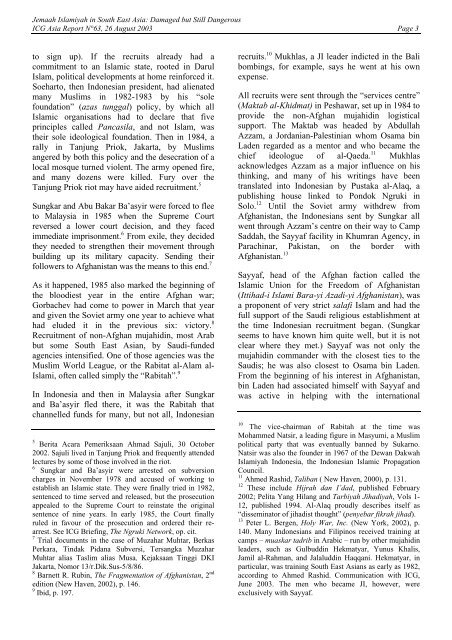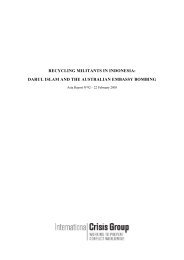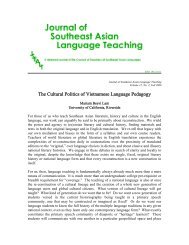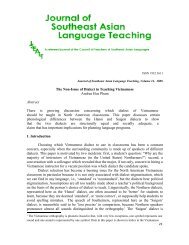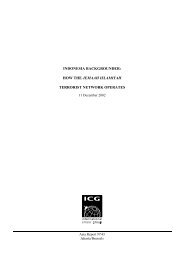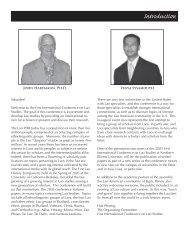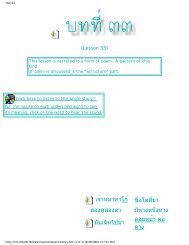jemaah islamiyah in south east asia: damaged but still ... - SEAsite
jemaah islamiyah in south east asia: damaged but still ... - SEAsite
jemaah islamiyah in south east asia: damaged but still ... - SEAsite
Create successful ePaper yourself
Turn your PDF publications into a flip-book with our unique Google optimized e-Paper software.
Jemaah Islamiyah <strong>in</strong> South East Asia: Damaged <strong>but</strong> Still Dangerous<br />
ICG Asia Report N°63, 26 August 2003 Page 3<br />
to sign up). If the recruits already had a<br />
commitment to an Islamic state, rooted <strong>in</strong> Darul<br />
Islam, political developments at home re<strong>in</strong>forced it.<br />
Soeharto, then Indonesian president, had alienated<br />
many Muslims <strong>in</strong> 1982-1983 by his “sole<br />
foundation” (azas tunggal) policy, by which all<br />
Islamic organisations had to declare that five<br />
pr<strong>in</strong>ciples called Pancasila, and not Islam, was<br />
their sole ideological foundation. Then <strong>in</strong> 1984, a<br />
rally <strong>in</strong> Tanjung Priok, Jakarta, by Muslims<br />
angered by both this policy and the desecration of a<br />
local mosque turned violent. The army opened fire,<br />
and many dozens were killed. Fury over the<br />
Tanjung Priok riot may have aided recruitment. 5<br />
Sungkar and Abu Bakar Ba’asyir were forced to flee<br />
to Malaysia <strong>in</strong> 1985 when the Supreme Court<br />
reversed a lower court decision, and they faced<br />
immediate imprisonment. 6 From exile, they decided<br />
they needed to strengthen their movement through<br />
build<strong>in</strong>g up its military capacity. Send<strong>in</strong>g their<br />
followers to Afghanistan was the means to this end. 7<br />
As it happened, 1985 also marked the beg<strong>in</strong>n<strong>in</strong>g of<br />
the bloodiest year <strong>in</strong> the entire Afghan war;<br />
Gorbachev had come to power <strong>in</strong> March that year<br />
and given the Soviet army one year to achieve what<br />
had eluded it <strong>in</strong> the previous six: victory. 8<br />
Recruitment of non-Afghan mujahid<strong>in</strong>, most Arab<br />
<strong>but</strong> some South East Asian, by Saudi-funded<br />
agencies <strong>in</strong>tensified. One of those agencies was the<br />
Muslim World League, or the Rabitat al-Alam al-<br />
Islami, often called simply the “Rabitah”. 9<br />
In Indonesia and then <strong>in</strong> Malaysia after Sungkar<br />
and Ba’asyir fled there, it was the Rabitah that<br />
channelled funds for many, <strong>but</strong> not all, Indonesian<br />
5 Berita Acara Pemeriksaan Ahmad Sajuli, 30 October<br />
2002. Sajuli lived <strong>in</strong> Tanjung Priok and frequently attended<br />
lectures by some of those <strong>in</strong>volved <strong>in</strong> the riot.<br />
6<br />
Sungkar and Ba’asyir were arrested on subversion<br />
charges <strong>in</strong> November 1978 and accused of work<strong>in</strong>g to<br />
establish an Islamic state. They were f<strong>in</strong>ally tried <strong>in</strong> 1982,<br />
sentenced to time served and released, <strong>but</strong> the prosecution<br />
appealed to the Supreme Court to re<strong>in</strong>state the orig<strong>in</strong>al<br />
sentence of n<strong>in</strong>e years. In early 1985, the Court f<strong>in</strong>ally<br />
ruled <strong>in</strong> favour of the prosecution and ordered their rearrest.<br />
See ICG Brief<strong>in</strong>g, The Ngruki Network, op. cit.<br />
7 Trial documents <strong>in</strong> the case of Muzahar Muhtar, Berkas<br />
Perkara, T<strong>in</strong>dak Pidana Subversi, Tersangka Muzahar<br />
Muhtar alias Taslim alias Musa, Kejaksaan T<strong>in</strong>ggi DKI<br />
Jakarta, Nomor 13/r.Dik.Sus-5/8/86.<br />
8 Barnett R. Rub<strong>in</strong>, The Fragmentation of Afghanistan, 2 nd<br />
edition (New Haven, 2002), p. 146.<br />
9 Ibid, p. 197.<br />
recruits. 10 Mukhlas, a JI leader <strong>in</strong>dicted <strong>in</strong> the Bali<br />
bomb<strong>in</strong>gs, for example, says he went at his own<br />
expense.<br />
All recruits were sent through the “services centre”<br />
(Maktab al-Khidmat) <strong>in</strong> Peshawar, set up <strong>in</strong> 1984 to<br />
provide the non-Afghan mujahid<strong>in</strong> logistical<br />
support. The Maktab was headed by Abdullah<br />
Azzam, a Jordanian-Palest<strong>in</strong>ian whom Osama b<strong>in</strong><br />
Laden regarded as a mentor and who became the<br />
chief ideologue of al-Qaeda. 11 Mukhlas<br />
acknowledges Azzam as a major <strong>in</strong>fluence on his<br />
th<strong>in</strong>k<strong>in</strong>g, and many of his writ<strong>in</strong>gs have been<br />
translated <strong>in</strong>to Indonesian by Pustaka al-Alaq, a<br />
publish<strong>in</strong>g house l<strong>in</strong>ked to Pondok Ngruki <strong>in</strong><br />
Solo. 12 Until the Soviet army withdrew from<br />
Afghanistan, the Indonesians sent by Sungkar all<br />
went through Azzam’s centre on their way to Camp<br />
Saddah, the Sayyaf facility <strong>in</strong> Khumran Agency, <strong>in</strong><br />
Parach<strong>in</strong>ar, Pakistan, on the border with<br />
Afghanistan. 13<br />
Sayyaf, head of the Afghan faction called the<br />
Islamic Union for the Freedom of Afghanistan<br />
(Ittihad-i Islami Bara-yi Azadi-yi Afghanistan), was<br />
a proponent of very strict salafi Islam and had the<br />
full support of the Saudi religious establishment at<br />
the time Indonesian recruitment began. (Sungkar<br />
seems to have known him quite well, <strong>but</strong> it is not<br />
clear where they met.) Sayyaf was not only the<br />
mujahid<strong>in</strong> commander with the closest ties to the<br />
Saudis; he was also closest to Osama b<strong>in</strong> Laden.<br />
From the beg<strong>in</strong>n<strong>in</strong>g of his <strong>in</strong>terest <strong>in</strong> Afghanistan,<br />
b<strong>in</strong> Laden had associated himself with Sayyaf and<br />
was active <strong>in</strong> help<strong>in</strong>g with the <strong>in</strong>ternational<br />
10<br />
The vice-chairman of Rabitah at the time was<br />
Mohammed Natsir, a lead<strong>in</strong>g figure <strong>in</strong> Masyumi, a Muslim<br />
political party that was eventually banned by Sukarno.<br />
Natsir was also the founder <strong>in</strong> 1967 of the Dewan Dakwah<br />
Islamiyah Indonesia, the Indonesian Islamic Propagation<br />
Council.<br />
11 Ahmed Rashid, Taliban ( New Haven, 2000), p. 131.<br />
12 These <strong>in</strong>clude Hijrah dan I’dad, published February<br />
2002; Pelita Yang Hilang and Tarbiyah Jihadiyah, Vols 1-<br />
12, published 1994. Al-Alaq proudly describes itself as<br />
“dissem<strong>in</strong>ator of jihadist thought” (penyebar fikrah jihad).<br />
13 Peter L. Bergen, Holy War, Inc. (New York, 2002), p.<br />
140. Many Indonesians and Filip<strong>in</strong>os received tra<strong>in</strong><strong>in</strong>g at<br />
camps – muaskar tadrib <strong>in</strong> Arabic – run by other mujahid<strong>in</strong><br />
leaders, such as Gulbudd<strong>in</strong> Hekmatyar, Yunus Khalis,<br />
Jamil al-Rahman, and Jalaludd<strong>in</strong> Haqqani. Hekmatyar, <strong>in</strong><br />
particular, was tra<strong>in</strong><strong>in</strong>g South East Asians as early as 1982,<br />
accord<strong>in</strong>g to Ahmed Rashid. Communication with ICG,<br />
June 2003. The men who became JI, however, were<br />
exclusively with Sayyaf.


